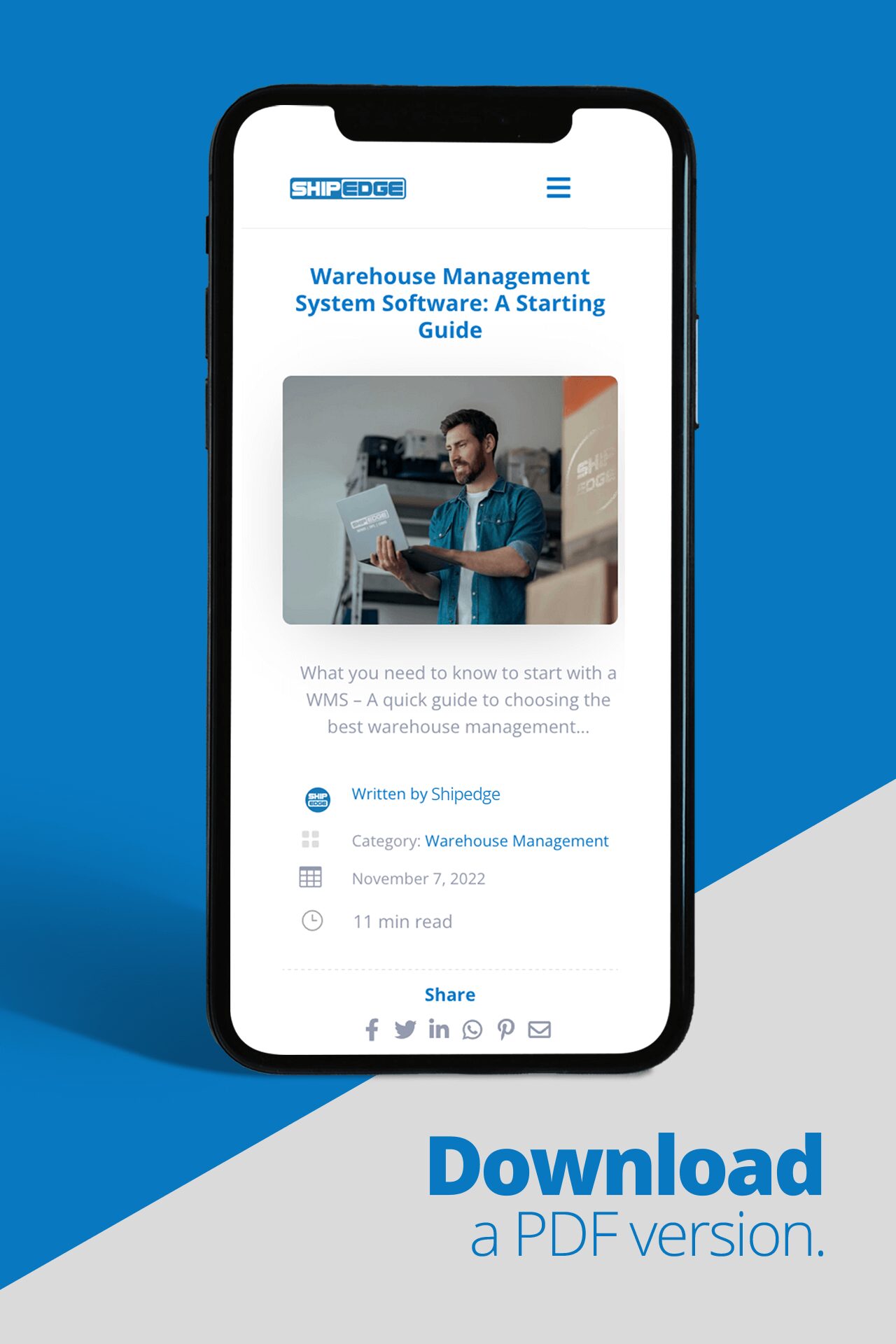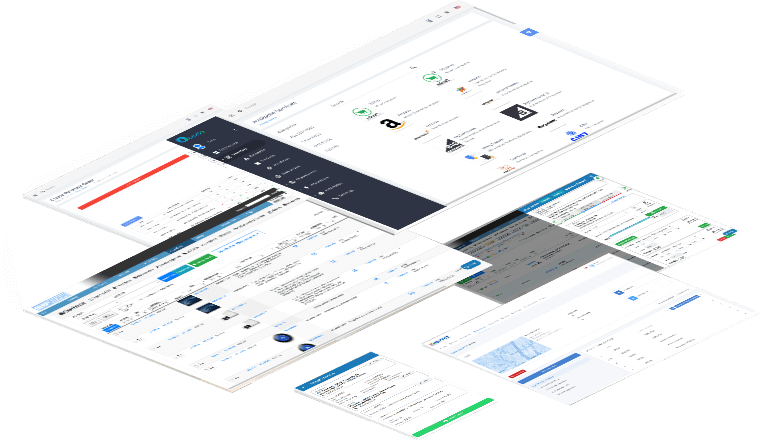In Part 2 of Third-Party Logistics (3PL) Essential Guide to eCommerce Fulfillment, we discussed how 3PLs could handle receiving both inventory and orders from their clients.
If you have not yet read Part 1 or 2, start there, and come back when you’re ready.
Read PART 1 of Third-Party Logistics (3PL) Essential Guide to eCommerce Fulfillment: Intro HERE
Read PART 2 of Third-Party Logistics (3PL) Essential Guide to eCommerce Fulfillment: Receiving HERE
In this part of our 3PL Guide to eCommerce Order Fulfillment, we will explore how 3PLs receive both inventory and orders from their clients.
Inventory Management and Storage
As your 3PL business starts to take on more clients, you will need to manage a large amount of product inventory stored in your warehouse until it is sold. Keeping this inventory organized and tracking stock counts accurately over time will make your team’s workday easier.
Fulfillment center warehousing is a vital part of your daily operations and putting together statements of process (SOPs) that reinforce best practices will ensure efficiency down the line and can save you a lot of money in overhead.
Some software platforms are built with these best practices in mind. We help most of our clients during the implementation process before go-live or give them a tune-up as they grow because we understand how critical this can be to your business’s overall success. A well-organized 3PL warehouse with smooth operational workflows is able to grow much faster and ensure they don’t hit roadblocks when scaling up.
Another helpful insight we’ve noticed in our experience working with successful 3PLs is that typically, the faster that product moves in and out of your warehouse, the better.
Order fulfillment is much more profitable than storage.
The goal for most 3PLs is not to store inventory, but to ship as much of it as possible and receive more to ship as the client sells the stored product. This is precisely the reason why Amazon charges high storage fees, as the goal for them is to make money on sold products and fulfillment.
Inventory Management Best Practices
We’ve compiled some inventory management best practices utilizing our industry experience over the last 10 years working with 3PLs and detailed them here for your convenience. If we can help you avoid some of the common pitfalls or integrate some of these best practices into your workflow, we think we can save you a lot of time, headaches, and money.
Barcode your locations and bins
Barcoding your locations and bins will help solidify your ability to leverage scanning-based workflows to validate inventory movement or other product management activities within your warehouse. In turn, preventing errors and ensuring your team has reliable information on where products are in the warehouse as well as what quantity is in a set bin or location.
When barcoding your locations and bins, you achieve new flexibility that doesn’t require you to barcode every single individual item. If the bin is barcoded, your pickers can scan that bin during their inventory management workflows to prevent errors. This means that you’ll save a lot of time and reduce overhead costs that would be required if you had to barcode every item as it comes into the warehouse.
Give your warehousing team mobile scanners and use them to log every move, recount, receipt, or activity that involves inventory
Using software systems in warehouse management is a no-brainer. They are (usually) designed to keep track of inventory accurately and efficiently in your 3PL fulfillment center. However, your software system can only be as good as the information you provide it with. Enabling your team to enter data at the exact time they are interacting with inventory will prevent errors and eliminate records being forgotten about and infrequently updated.
Place products that move quickly or have high sell-through rates closer to your outbound dock
Making high-demand products accessible to pickers will make your order fulfillment much easier and quicker. Pickers won’t have to go deep into the warehouse every time that popular order is placed. Over time, this will lower the distance of travel required for each pick. Third-party fulfillment centers typically use “areas” to organize sell-through rates.

Area A: closest to outbound docks, used to store small to medium-sized items that typically sell through in a few days
Area B: used as storage for small to medium products that sell through in a week or longer
Area C: deepest level back, used to store bulk items or pallets used for refills
Utilizing this model will help your pickers fulfill orders faster by minimizing how far they need to walk to reach certain products. Large products or pallets used to refill these high-traffic locations are stored at the warehouse’s deepest or farthest level because they will most likely require a forklift. Because driving is faster than walking, organizing your fulfillment center in a way that naturally encourages equipment to be used at the right time, preventing bottlenecks a forklift may cause for picking efficiency.
Don’t store products by customer
It’s not uncommon for 3PLs to create storage for customers, rather than products. In a fulfillment center without a WMS, you may not have the available resources to keep up with varying product space from multiple clients across the warehouse floor. However, if you have a 3PL warehousing system in place, organizing your warehouse by customer will cause you to miss out on other, potentially more profitable ways to manage storage and their benefits
- When you mix products in rows and/or bays across customers, you eliminate unused space by utilizing all available space in your warehouse. This helps you save money on square footage costs as you grow.
- Your picking will become more efficient if you can store products by sell-through rate, or how often your pickers need to pick them. Place the items they will need to pick more often closer to the outbound dock or where they start their pick path.
- If you have large clients that make up a big chunk of your order volume, which happens quite often, your team members won’t get stuck in the same aisle or rows trying to access that same client’s inventory as their stock will be more spread out around the warehouse.
Physical Storage Location Types
There are many different types of storage options, and many third-party logistics companies use multiple storage methods, which may include:
- Pallet Racking: A storage system using vertical space to stack pallets of products on horizontal beams. This allows for maximum storage density and easy access to products using a forklift and pallet jack.
- Product Bin Storage: Products are stored in individual bins or containers, as opposed to storage by customers. This allows for easy organization and inventory management of small items.
- Floor Storage: Products are stored directly on the warehouse floor. This is typically used for bulky or heavy items that are not easily stored on pallet racks or in bins.
- Special Storage Areas:
- High-Security Areas: Used to store valuable or sensitive items that require extra security measures.
- Temperature Control: Intended for items that require a specific temperature range to maintain quality or safety standards (this often includes food products or medicines).
- Hazmat Storage: Used when products are considered hazardous materials that require specific handling and storage.
- Flow Bins: Used to store and move products in a specific order or sequence, and are typically used in manufacturing or assembly lines.
Order Fulfillment
Now that you’ve received inventory and your customers have orders flowing, it’s time to optimize your eCommerce order fulfillment workflow. This starts with picking.
Picking
This is when a fulfillment center team member grabs products for orders that need to be fulfilled.
Tips: The better organized your warehouse is, the more scalable and efficient this process will be. This starts with organizing the inventory in your warehouse and the locations in which they are stored. Setting inventory rotation rules by the type of storage also helps to save time and remove bottlenecks. As an example, setting the first level of storage racking or hand-pickable locations as a priority (by default) reduces situations where someone is waiting on a forklift or equipment to reach higher locations for their pick.
Packing
Taking picked products and packing them into the correct packaging.
Tips: Selecting the optimal packaging will save you and your clients a lot of money on shipping. The last thing you want to do is to ship a box of air at your client’s expense. Utilizing our cartonization engine allows your packer to save valuable time deciding what packaging to use. At the time of packing, the software will automatically suggest the best box for the item(s). Shipedge will also stop recommending packaging that is out of stock or unavailable for a specific shipment.
Quality Control
Checking that the correct products and quantities of items are placed into each order
Tips: Our mobile app incorporates picking workflows and Quality Control, so there is no need to implement an extra step to check for accuracy. A pick and pack scan is done during the picking process, which serves as a quality control check. This allows for more efficient fulfillment.
Shipping
Generating a shipping label to get the order to the consumer
Tips: Generating shipping labels is an essential part of the fulfillment process and the cheaper the label, the more competitive you will be as a third-party logistics provider. We are able to generate shipping labels with 100+ carriers directly from our software and can help automatically rate shops across many carrier service levels to ensure that you get the cheapest label every time. This saves your team time and your customers’ money, which is the cornerstone to building strong relationships with your clients.
Organizing and Prioritizing eCommerce Orders for Fulfillment
Prioritizing On-Time Delivery
One of the most important metrics for eCommerce sellers is delivery times. The clock starts when orders are paid for and start to flow into a 3PLs order management system for fulfillment. Certain channels will have more stringent requirements than others, such as Amazon. Amazon uses the on-time delivery metric to rate their sellers. Violations of this metric can cause a seller’s account to be frozen. How quickly a third-party logistics company can fulfill customers’ orders also directly impacts metrics like customer satisfaction for eCommerce companies.

We typically see successful 3PLs organize fulfillment waves by must-ship-by dates as well as order creation dates. This allows your team to work on fulfilling orders sequentially based on the date they came into the system. Your team will be able to prioritize orders that need to reach the client sooner based on different shipping service levels dictated by the shopping cart or marketplace.
Organizing Order Waves to Prioritize Picking Efficiency
Picking single-item orders first allows you to use a batch-picking workflow to increase the number of picks per hour and orders you are able to fulfill per member of your picking team.
- Create filters for orders that only contain one item
- Batch orders to pre-generate labels
- Generate or assign a batch-picking pick path
- Pick items and bring them back to packing stations
- Print labels and pack items one SKU at a time
While order size can vary greatly depending on your business, a general rule of thumb is that eCommerce orders will be between 1-3 items. Many eCommerce orders will only contain one item. Picking a lot of the same item and printing their respective labels allows you to process hundreds or thousands of orders in an hour, greatly increasing fulfillment productivity across the board.
Then, you can run picking carts with 20 to 50 orders for the rest of the orders containing 2-10 items. Picking using a cart containing multiple orders will also greatly increase your picking efficiency. Our software allows this process to be done by a single person, permitting you to process more picking carts full of orders and reducing bottlenecks that typically occur with a two-person picker & packer process. This workflow can run in Shipedge when appropriate.
This leaves edge cases for bulky products or orders that require special handling for later steps in the process. Organizing your picking operations in this way reduces the number of team members you need per shift and increases your overall fulfillment capacity.
Discover how our WMS can improve your business
Shipping Orders for Clients
Utilizing multiple shipping carriers allows you to provide cost-effective shipping to the brands that you work with. Depending on what countries you offer fulfillment services in, different carriers will make more or less sense. There are tons of carriers to choose from and shipping rates will vary based on shipping distance, service level, weight, and many other factors.
Some common carriers for domestic shipping in the United States are USPS, UPS, FedEx, and DHL eCommerce. With just these carriers, you’ll have many service levels like ground, expedited, next-day, same-day, lightweight, and more.
Check out our shipping carrier integrations here
Feeling overwhelmed? Don’t worry! We’ve got you covered with automated rate shipping. All you have to do is:
- 1. Connect your carrier accounts or utilize our pre-generated accounts with discounted rates
- 2. Create BRP shipping rules where you will define which carriers are considered for certain situations
- 3. Create your first label generation batch using your BRP codes as the shipping methods.
FAQs – Click to learn more
How do I package and ship eCommerce orders efficiently and effectively?
How do I integrate my WMS and OMS with eCommerce platforms or marketplaces?
What Key Performance Indicators (KPIs) should I look for, and how do I track them?
• Inventory turnover rate: How quickly inventory is being sold and replaced
• Order picking accuracy: Measures the accuracy of order fulfillment by pickers
• Order lead time: Measures the time it takes from when an order is placed to when it is shipped
• Shipping accuracy: Measures the accuracy of shipping labels and delivery addresses
• Return rate: Measures the percentage of orders that are returned
How do I scale as my business grows?
How can I improve the speed and accuracy of eCommerce order fulfillment?
• Optimize your warehouse layout: By using an optimized naming system for locations, bins, aisles, levels, etc in your warehouse, there will be less confusion among workers about exactly where they should look for inventory. Over the years, Shipedge has collected data and conducted warehouse science research to determine the most efficient naming structure. You can learn more about our naming structure here.
• Use barcode scanning: By using barcode scanning in the warehouse, you can increase the accuracy and speed of order fulfillment.
• Use real-time inventory tracking.
• Leverage automation technology.
Starting a 3PL business holds opportunities for lucrative success, but can be difficult when you don’t know where to start or know what resources will benefit you the most. If you have any questions about starting your 3PL, eCommerce order fulfillment, or would like clarification on any topics discussed in our articles, reach out to a solutions engineer below.
Discover how our WMS can improve your business












0 Comments